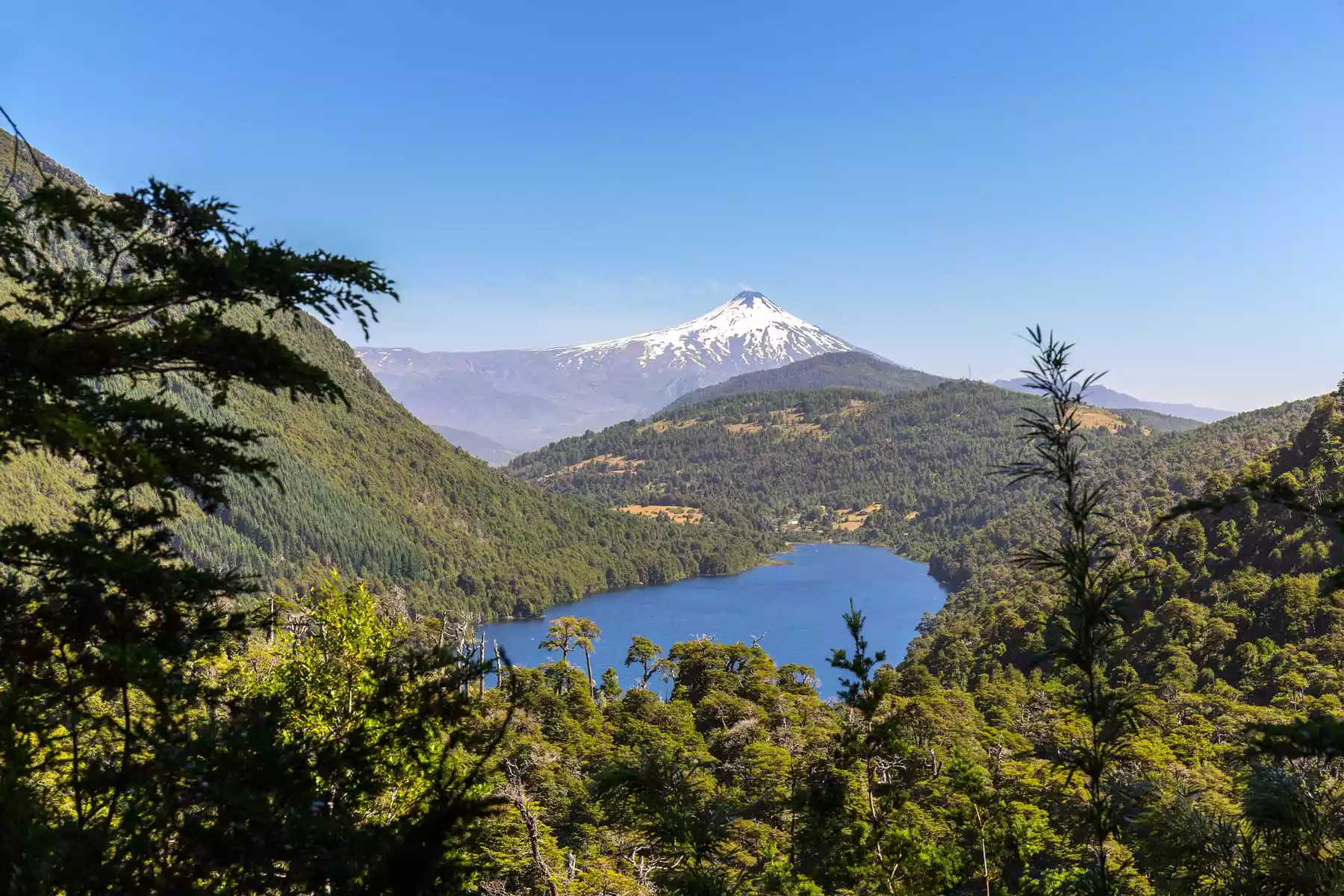Summary
Exploring a kingdom of ancient trees, snowcapped mountains, and clear glacial waters.
Fact checked by Jillian Dara
1. Exploring Huerquehue National Park
There’s a spot about four miles into the Los Lagos Trail, in Chile’s Huerquehue National Park, where venerable araucaria trees preside over a primordial rain forest. They pop like umbrellas from lumpy hills; they curve like palms over placid lagoons. Araucarias are so ecstatic, so top-heavy in their design, that they seemed to punctuate the path ahead of us like giddy exclamation marks.
My partner, Felipe, and I had been hiking all morning just to see them. The higher we climbed, the colder the forest became. Of course, the trees don’t mind; they’re dressed for the weather in fur coats of pea-green lichen. Araucarias grow only in Chile and Argentina, and only at altitudes above 3,000 feet. Perhaps that’s why this area, about 500 miles south of Santiago, has become a place of pilgrimage for us over the years. It was our first trek down this particular trail but our fifth time among the magical araucarias.

2. Culinary Adventures at andBeyond Vira Vira
The Lake District was my introduction to Chile a decade ago, when I first visited Felipe’s homeland. I was already sold on him, but I suppose this is what sold me on his country. A few years later, I dropped everything to move from Brooklyn to Santiago so I could have places like this at my fingertips. Neither as Mediterranean as central Chile to the north nor as raw as Patagonia to the south, the Lake District calls to mind the Pacific Northwest—if you squeezed the volcanoes closer together and sprinkled in two dozen lakes.
Our first base was andBeyond Vira Vira (doubles from $1,590). This property near the fashionable resort town of Pucón embodies understated luxury, soothing guests with earth tones and natural textiles in its villas. Just upstream is the resort’s organic farm, where chef Damián Fernández sources ingredients for his seasonal menus. For adventure, andBeyond swaps game drives for trout fishing, whitewater rafting, and hikes up the cartoonishly conical Villarrica volcano.

3. Relaxation at Termas Geométricas
After our adventure, we ventured to the south side of the volcano to decompress at Termas Geométricas. This hot springs complex features scarlet boardwalks and 20 steaming pools situated in a fern-filled river canyon, providing a serene experience for guests like us after a day of hiking.

4. Discovering Local Artisans
Felipe is the subdirector of an art museum in Santiago, so regional arts and crafts were also on the agenda. The following morning, we tracked down the studio of textile artist Sandra Rojos, whose vibrant telares adorn the walls of Vira Vira. On our way out of town, we visited the workshop of Hector Bascuñán Briones, whose hand-carved bowls filled with home-baked bread had a unique character. We found even greater discovery at the Escuela de Oficios, an artist collective inspiring modern pottery free from tradition.
5. Adventures around Lago Panguipulli
We turned our attention back to the adventures ahead, veering along the northern shore of Lago Panguipulli, bordered by tall, forested hills. The private Huilo Huilo Biological Reserve encompasses 297,000 acres of rich biodiversity, including fairy-tale lodges. We opted for the secluded Nawelpi Lodge (doubles from $252), which offers plush cabins overlooking La Leona waterfall.

6. Exploring Futangue Park
The estancia-themed property of Futangue Hotel & Spa is a luxurious base camp for exploring nearby Futangue Park. This adventureland is filled with emerald lagoons and crashing waterfalls. General manager Pascal Rosales mentioned the park only admits about 8,000 visitors each year, allowing for a serene experience, which we appreciated. Our hike up Cerro Mayo offered breathtaking views of the rain forest and the distant araucarias where it all began.
In conclusion, our journey was a blend of adventure, relaxation, and local culture—a perfect reflection of what Chile’s Lake District has to offer.





